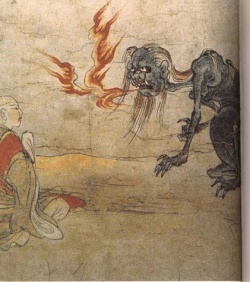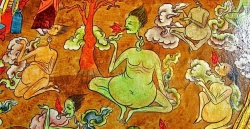Difference between revisions of "Kumbhanda"
| Line 12: | Line 12: | ||
[[File:Hungry ghost774lk.jpg|thumb|250px|]] | [[File:Hungry ghost774lk.jpg|thumb|250px|]] | ||
[[Kumbhanda]] (Skt. [[kumbhāṇḍa]]; Tib. {{BigTibetan|[[གྲུལ་བུམ་]]}}, [[Wyl.]] [[grul bum]]) - a class of {{Wiki|demons}} said to dwell in {{Wiki|cemeteries}}. Norbu/Clemente (1995) says that they live in the sea and have [[human]] [[bodies]] with [[animal]] heads | [[Kumbhanda]] (Skt. [[kumbhāṇḍa]]; Tib. {{BigTibetan|[[གྲུལ་བུམ་]]}}, [[Wyl.]] [[grul bum]]) - a class of {{Wiki|demons}} said to dwell in {{Wiki|cemeteries}}. Norbu/Clemente (1995) says that they live in the sea and have [[human]] [[bodies]] with [[animal]] heads | ||
| − | {{Wiki|Demon}} of [[Buddhist]] {{Wiki|myth}}, said to drain [[human]] [[life]] [[energy]]. He has dark {{Wiki|skin}} and stands 3 meters tall, but sometimes changes shape to gourd. Known to have once severed {{Wiki|Rudra}}, the [[god]] of storms. | + | {{Wiki|Demon}} of [[Buddhist]] {{Wiki|myth}}, said to drain [[human]] [[life]] [[energy]]. He has dark {{Wiki|skin}} and stands 3 meters tall, but sometimes changes shape to {{Wiki|gourd}}. Known to have once severed {{Wiki|Rudra}}, the [[god]] of storms. |
A class of {{Wiki|spirits}} mentioned with [[Yakkhas]], [[Asuras]] and [[Nagas]]. They live in the [[South]] and [[Virulha]] is their [[king]] (D.ii.257; D.iii.198). In the [[Vidhurapandita Jataka]] (J.vi.272), [[Kumbhira]] (q.v.) is mentioned as one of their chiefs. They had huge stomachs, and their genital {{Wiki|organs}} were as big as pots, hence their [[name]]. DA.iii.964 | A class of {{Wiki|spirits}} mentioned with [[Yakkhas]], [[Asuras]] and [[Nagas]]. They live in the [[South]] and [[Virulha]] is their [[king]] (D.ii.257; D.iii.198). In the [[Vidhurapandita Jataka]] (J.vi.272), [[Kumbhira]] (q.v.) is mentioned as one of their chiefs. They had huge stomachs, and their genital {{Wiki|organs}} were as big as pots, hence their [[name]]. DA.iii.964 | ||
| Line 24: | Line 24: | ||
They had huge stomachs, and their genital {{Wiki|organs}} were as big as pots, hence their [[name]]. DA.iii.964. | They had huge stomachs, and their genital {{Wiki|organs}} were as big as pots, hence their [[name]]. DA.iii.964. | ||
| − | A class of [[beings]] ({{Wiki|fairies}} or gnomes) grouped with [[Yakkhas]], [[Rakkhasas]], [[Asuras]] and others. [[Virulha]] is their [[king]]. They have large bellies ([[kumbhanda]] = gourd), and their genitals are also [[large like pots]] ([[kumbho viya]]), hence their [[name]]. D.iii.198; DA.iii.964 | + | A class of [[beings]] ({{Wiki|fairies}} or gnomes) grouped with [[Yakkhas]], [[Rakkhasas]], [[Asuras]] and others. [[Virulha]] is their [[king]]. They have large bellies ([[kumbhanda]] = {{Wiki|gourd}}), and their genitals are also [[large like pots]] ([[kumbho viya]]), hence their [[name]]. D.iii.198; DA.iii.964 |
------------------------------------------------------------------------------------------------------------------ | ------------------------------------------------------------------------------------------------------------------ | ||
Revision as of 15:34, 7 April 2014
kumbhanda
鳩槃荼 (Skt; Jpn kuhanda)
A Kumbhāṇḍa (Sanskrit) or Kumbhaṇḍa (Pāli) is one of a group of dwarfish, misshapen spirits among the lesser deities of Buddhist mythology.
Kumbhāṇḍa was a dialectal form for "gourd", so they may get their name from being thought to resemble gourds in some way, e.g. in having big stomachs. But kumbhāṇḍa can also be interpreted as "pot-egg"; since "egg" (aṇḍa) was a common euphemism for "testicle", the kumbhāṇḍas were imagined having testicles "as big as pots".
The terms kumbhāṇḍa and yakṣa are sometimes used for the same person; yakṣa in these cases is the more general term, including a variety of lower deities.
The kumbhāṇḍas are classed among the Cāturmahārājikakāyika deities, and are subject to the Great King Virūḷhaka, Guardian of the South. One of their chiefs is called Kumbhīra.
Kumbhanda (Skt. kumbhāṇḍa; Tib. གྲུལ་བུམ་, Wyl. grul bum) - a class of demons said to dwell in cemeteries. Norbu/Clemente (1995) says that they live in the sea and have human bodies with animal heads
Demon of Buddhist myth, said to drain human life energy. He has dark skin and stands 3 meters tall, but sometimes changes shape to gourd. Known to have once severed Rudra, the god of storms.
A class of spirits mentioned with Yakkhas, Asuras and Nagas. They live in the South and Virulha is their king (D.ii.257; D.iii.198). In the Vidhurapandita Jataka (J.vi.272), Kumbhira (q.v.) is mentioned as one of their chiefs. They had huge stomachs, and their genital organs were as big as pots, hence their name. DA.iii.964
The terms kumbhāṇḍa and yakṣa are sometimes used for the same person; yakṣa in these cases is the more general term, including a variety of lower deities. The kumbhanda ghost (paralysis ghost). When a person falls under the influence of such a ghost, his hands and feet are intact, not missing, his seeing and hearing are not distorted or confused, and yet his mind has come under a deviant influence, so that he is unable to move. One of their chiefs is called Kumbhīra.
Kumbhanda.-A class of spirits mentioned with Yakkhas, Asuras and Nāgas.
In the Vidhurapandita Jātaka (J.vi.272), Kumbhīra is mentioned as one of their chiefs.
They had huge stomachs, and their genital organs were as big as pots, hence their name. DA.iii.964.
A class of beings (fairies or gnomes) grouped with Yakkhas, Rakkhasas, Asuras and others. Virulha is their king. They have large bellies (kumbhanda = gourd), and their genitals are also large like pots (kumbho viya), hence their name. D.iii.198; DA.iii.964
Dharma Master Heng Ch'ien's encounter with the kumbhanda ghost and his experiences with other types of ghosts described in the first issue of Vajra Bodhi Sea. The kumbhanda tried for about half an hour to smother him under an invisible force field, and the troupe of visiting friends turned out to be ghosts who frequently urged him to destroy himself using their powers of concentration to threaten his life.
This troupe followed him from Seattle, where he first encountered them, to San Francisco when he went to cultivate the Buddhadharma under his teacher, the Venerable Tripitaka Master Abbot Hsuan Hua. They stood in the street below the Buddhist Lecture Hall calling his name and howling in the night, but never dared come up the stairs to get him. Since he has resided at Gold Mountain Dhyana Monastery, the ghosts have not come around at all.
On a few occasions, however, when he has had-to be absent from the Monastery, the ghost troupe has instantaneously picked up on his departure and followed him. Once when he visited his mother who was ill they went after him with great intensity, following him right to his parent's home. But when he returned to Gold Mountain Monastery, the ghosts became frightened and left. Throughout this time, when he was near the Venerable Abbot, the ghosts did not dare to bother him.

